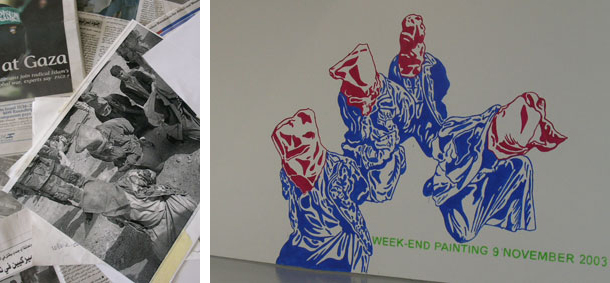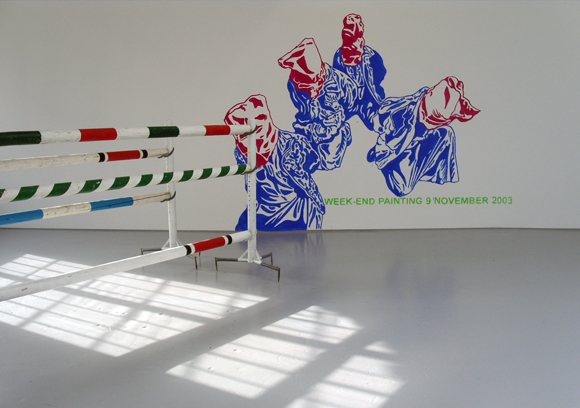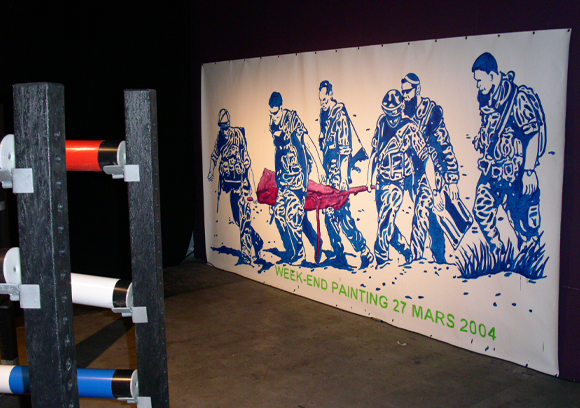| |
|
|
06.
| Week end paintings |
| |


2002-2005, wall painting, in situ.
Exhibition view from Obstacles, Next flag, Migros Museum, 2003, Zürich.
Courtesy of the artist.
'' The Weekend Paintings show images of real-time news taken from newspapers, striking images sometimes highly representative of the times,
of history in the making, yet at the same time taken from an incessant flow that makes us immediately forget them,
rendered banal by our being used to such images, if it weren’t for this capture in time that freezes them in a particular time and place – that of the gallery, the museum – and forces us to change the way we look at them. ''
Marie Deparis

Week end paintings
Exhibition view from Obstacles, Next flag, Migros Museum, 2003, Zürich.
Courtesy of the artist.

Week end paintings
Exhibition view from Les afriques - Lille 2004 capitale européenne de la culture, Tri postal, 2003, Lille.
Courtesy of the artist.
|
|
|
|
|
|
Le jeu de mot sur l’expression « peinture du dimanche », comme on dit d’un artiste dilettante qu’il est un « peintre du dimanche », souligne d’emblée le caractère non systématique de ce type de proposition dans le travail de mounir fatmi. Les peintures du dimanche, comme leur nom l’indique, se décident et se produisent le week-end, lorsque deux conditions sont réunies : d’une part, la possibilité pour l’artiste de travailler in situ, dans le cadre d’une exposition personnelle ou non, d’un projet particulier, d’autre part, lorsque l’actualité du week-end se prête à une réaction de l’artiste.
Elles ont aussi une portée symbolique en ce que, faites le dimanche, elles renvoient à la dimension religieuse de ce jour particulier dans le calendrier catholique.
Enfin, la spécificité de ce travail, circonscrit dans une unité de temps et de lieu, est également une façon pour l’artiste de se positionner comme toujours en alerte, même le week-end, lorsque ailleurs en Occident le loisir prend le pas sur la vigilance, la capacité à s’indigner se met en sommeil au profit du délassement.
Les week-end paintings donnent à voir des images de l’actualité immédiate, prises dans des journaux, images choc ou hautement significatives du temps présent, de l’histoire en train de se faire en même temps qu’images que le flux médiatique aurait tôt fait de nous faire oublier, rendues banales par l’habitude de telles images, si ce n’était cette capture temporelle, qui, les figeant dans un espace et un temps particuliers –ceux de la galerie, du musée- nous oblige à un autre regard.
En effet, la frontalité, le recadrage, le traitement en grandeur nature, le choix des couleurs vives sur le fond mural blanc rendent une intensité presque réaliste à ces images. Nous voici à la fois témoin et voyeur face à une image qui, passée au filtre de l’esthétisation, donne à voir une certaine beauté, ne serait-ce que formelle – ce faisant, l’artiste pose à nouveau au passage la question de l’esthétique du mal- dans ce qui n’est souvent que drame. Mounir Fatmi interroge ainsi l’ambiguïté de notre appréhension de l’image d’actualité. Car si nous mettons entre parenthèses le choix que nous imaginons déterminé de l’artiste de telle image plutôt que telle autre, l’image proposée, dénuée de tout commentaire, projetée là comme devant parler d’elle-même, impose une sorte de neutralité qui, en miroir, renvoie à l’obligation de se questionner sur ce que nous en comprenons, sur la manière dont nous l’interprétons, sur la façon dont celle-ci s’imprime dans nos mémoires sélectives
Marie Deparis
|
|
The play on words in the expression “weekend painting”, as one says of an amateur artist that he is a “weekend painter”, immediately highlights the non systematic aspect of this type of proposition within Mounir Fatmi’s work. Weekend Paintings, as their name suggests, are decided upon and produced during the weekend, when two conditions are met: one, the possibility for the artist to work in situ, in the context of a exhibit, personal or not, or of a particular project, and two, when the news happening that weekend calls for a reaction from the artist.
They also have a symbolic meaning in the sense that, as they are produced on a Sunday, they highlight the religious dimension of this particular day in the Catholic calendar. Finally, the specificity of this work, contained within a specific time and place, is another way for the artist to always remain on alert, even on the weekend, when elsewhere in the Western world leisure supplants vigilance, the capacity for indignation is set aside in favor of relaxation.
The Weekend Paintings show images of real-time news taken from newspapers, striking images sometimes highly representative of the times, of history in the making, yet at the same time taken from an incessant flow that makes us immediately forget them, rendered banal by our being used to such images, if it weren’t for this capture in time that freezes them in a particular time and place – that of the gallery, the museum – and forces us to change the way we look at them.
Indeed, the frontality, the cropping, the life-size rendering, the choice of vivid colors against a uniform white wall give these images an almost realistic intensity. Here we are, witness and voyeur at the same time, faced with an image which, through the filter of aestheticization, shows a certain beauty, if only in a formal sense – in doing so, the artist poses once again the question of the aesthetic of evil – in what is usually nothing but tragedy. Mounir Fatmi thus questions the ambiguity of our apprehension of news images. If we set aside the assumingly determined choice of the artist for this or that image, the proposed image, stripped of any commentary, projected here as if having to speak for itself, imposes a certain neutrality that, conversely, reminds us of our obligation to question what we understand, the way we interpret and the way it etches itself in our selective memories.
Marie Deparis
|
|
|
|